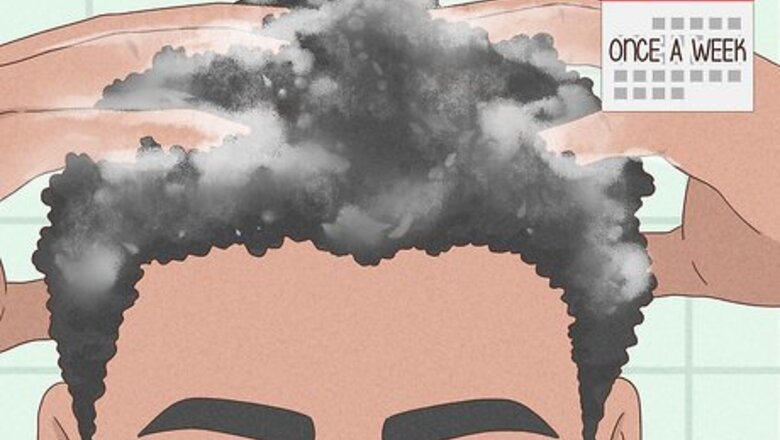
views
Shampoo your hair once a week.

Your hair is healthiest when it isn’t washed too often. Shampoo strips away your hair’s natural oil, and when it’s used too often, your hair can end up weak and brittle. For kinky or afro-textured hair, it’s okay to wash your hair with shampoo once a week, or even once every other week.
Use sulfate-free shampoo.

A sulfate-free shampoo is a gentle alternative to traditional shampoos. Sulfates are one of the major culprits when it comes to chemicals in shampoo that can harm your hair, so opting for a shampoo that doesn’t use this ingredient can improve your hair’s health. Sulfate-free shampoo is especially useful for people with kinky hair. When washing your hair, you may decide to to use 2 shampoos: first, a clarifying shampoo to get rid of any dandruff or product in your hair, then a moisturizing shampoo to add moisture to your hair.
Apply a rinse-out conditioner with each shower.
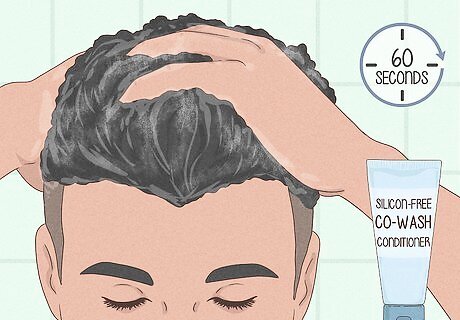
Conditioners are useful for more than just moisturizing your hair. Since you’ll ideally be washing your hair with shampoo less often, rubbing conditioner into your scalp and hair at least few times a week can keep excess oil at bay. Be sure to rinse out your conditioner thoroughly after using it, for at least 60 seconds. As a guy with kinky hair, you might want to try a silicone-free co-washing conditioner. If your hair feels particularly dry, deep condition it with a product that has a base of shea butter, honey, or avocado.
Moisturize your hair daily.

For kinky hair to look its best, it needs to be moisturized. A daily hair moisturizer is the key to softer, frizz-free hair. Since the oils in kinky hair typically don’t reach down to the roots, applying a daily moisturizer by rubbing a small amount in your hands before spreading it through your hair can make your locks look fantastic. Use your moisturizer before combing your hair, heading outside, or going to sleep.
Use a few drops of oil on your scalp.

Black hair tends to be dry, and that extends to the scalp, too. You probably already know that it’s a good idea to moisturize your skin, but you might not realize that this includes your scalp. Try massaging a several drops of sweet almond oil on your scalp. You can also use a lightweight oil like argan oil or black seed oil. These oils can also promote hair growth.
Dry your hair with a microfiber towel or t-shirt.
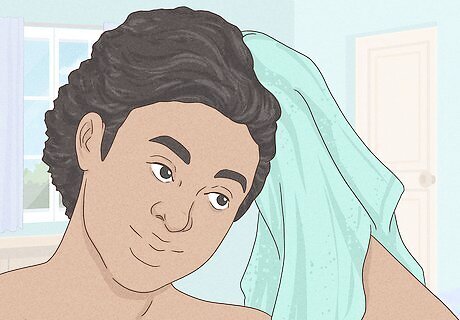
Limit friction when towel drying your hair to avoid breakage. A microfiber towel or even an old t-shirt is a much more gentle alternative to drying your hair with a normal towel. Instead of roughly rubbing your head to dry it, just gently push your microfiber towel or t-shirt into your hair to mop up excess water. If your hair is really dry, you may even want to use a paper towel to soak up its water, since this can leave your hair with more moisture.
Style your hair with pomade or curl cream.
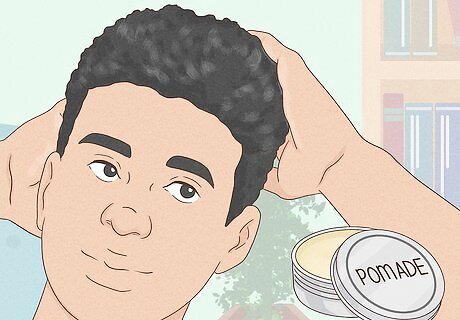
Products made for black hair work better than gel. When you’re ready to style your hair for the day, reach for a pomade or curl cream that is formulated for black hair. The best products don’t use mineral oil, instead opting for flaxseed oil or shea butter that works well with afro-textured hair. Try not to style your hair with heat, but if you do, be sure to use a heat protectant.
Brush your hair with a wide-tooth comb.
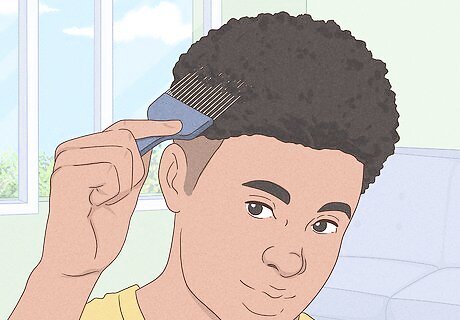
Wide-tooth combs or afro picks are gentle when used on wet hair. These kinds of combs are way less likely to lead to breakage in your hair. Remember to comb your hair only when it's dry, since brushing it while wet can lead to damage. Comb your hair to preserve its shape, rather than to remove tangles. For tangle, use your fingers and a little bit of oil.
Protect your hair from friction while sleeping.
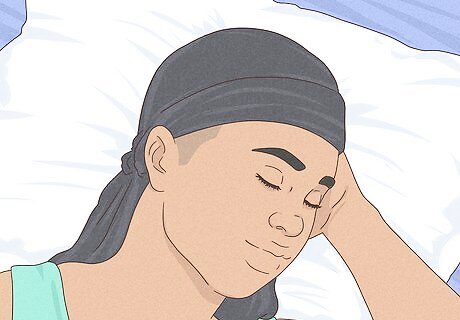
A durag or silk pillowcase keeps your hair from breaking at night. Sleeping on cotton pillowcases can create a lot of friction at night, which can cause your hair to become frizzy or lead to breakage. Tying a durag is both simple and an effective way of protecting your hair at night.
Use a protective style during colder weather.
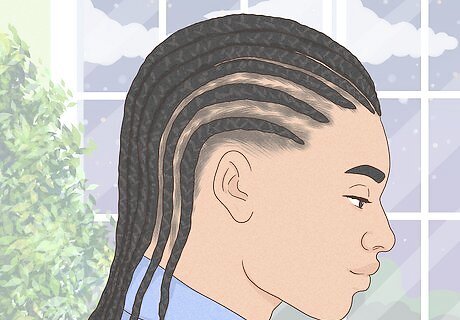
Protective styles keep your hair healthy even in bad weather conditions. As it gets colder and drier in the winter, your hair may end up becoming more prone to breakage and frizz. A protective style for guys, like styling your hair in locs, braiding cornrows, or trying out twists, can keep your hair healthy as it grows, while looking great. Protective styles shouldn’t hurt. If your scalp hurts while it’s being styled, loosen it—putting too much tension on your scalp can lead to hair loss.
Avoid chemical hair treatments.
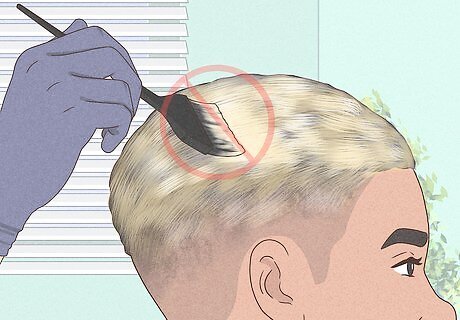
Chemical treatments can easily damage natural hair. Chemical processes like bleaching or using hair relaxers can damage the structure of your hair, making it harder for them to take in moisture and leaving them with a lifeless look. If you do want to try out a new look—either by dying your hair or using a chemical relaxer—be sure to work with an experienced stylist who can help you protect your hair.
Eat a balanced and nutritious diet.
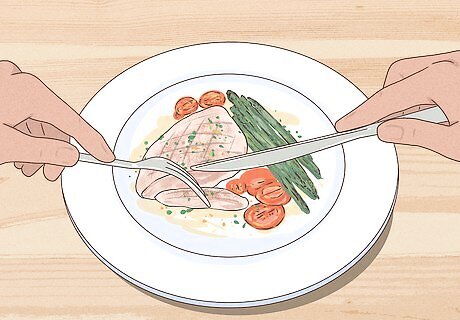
Nutrients like vitamin C and omega-3s lead to healthier, stronger hair. To have the best hair possible, be sure that you’re eating a diet that has essential vitamins and nutrients, like protein, vitamin C, iron, and omega-3 acids. While you can always take supplements to get these nutrients, you can also find them naturally in certain foods: Protein: Lean protein sources are found in chicken, eggs, tofu, and beans. Vitamin C: Citrus fruits, like oranges and lemons, are packed with this vitamin, as are peppers, strawberries, and tomatoes. Iron: Iron is in red meat, beans, dried fruit, and fortified breakfast cereals. Omega-3 acids: Omega-3s are in fish, nuts, and plant oils, like canola or soybean oil.




















Comments
0 comment